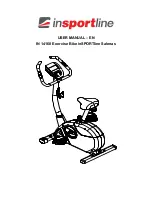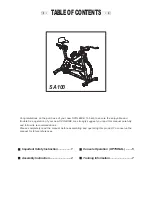
Summary
-
Make sure if a fitness training doesn’t
cause problems for your health.
-
Evaluate your level of power, endurance,
flexibility, speed and coordination before
you start training.
-
Set realistic goals based on your physical
possibilities.
-
Set up a training program for a longer
period (6 to 12 months)
-
Divide your long term planning up into
different cycles (meso cycle) of 4 to 6
weeks.
-
Make sure there is enough variation in
your training. Train on endurance, power
and muscle development.
If you choose for endurance training, vary
between short, mid-long and long training
periods.
-
In de loop van een mesocyclus dient u de
intensiteit van de training te verhogen,
zowel voor uithouding als voor
spiertraining. Beperk de intensiteit van de
training steeds in de beginfase van elke
nieuwe cyclus.
-
Evalueer regelmatig uw training om te zien
of u op het goede spoor zit en of u de
belangrijkste doeleinden kan bereiken,
indien niet :
-
During a meso cycle you have to increase
the intensity of the training for endurance
as well as for muscle training. Limit the
intensity of the training in the beginning of
every new cycle.
-
Evaluate regularly your training to make
sure you are on the right track and if you
can achieve your most important goals, if
not:
•
Adapt the next meso cycle
•
Repeat the initial test
•
Do interim tests at the end of every meso cycle
Success
Even after a short period of regular exercises
you will realise that you constantly have to
increase the pedalling resistance to reach your
optimum pulse rate.
The units will be continuously easier and you
will feel a lot fitter during your normal day.
For this achievement you should motivate
yourself to exercise regularly. Choose fixed
hours for your work out and do not start
training too aggressively.
An old saying amongst sportsmen says:
“
The most difficult thing about training is to
start it
.”
Wishing you lots of fun and success with
your exerciser
.
All data displayed are approximate
guidance and cannot be used in any
medical application.
Heart rate displayed is an approximate
read-out, and may not be used as
guidance in any cardio-vascular related
medical or paramedical program.
Summary of Contents for EF-2
Page 1: ......
Page 2: ......
Page 12: ...140 kg 1 2...
Page 14: ...4 2 1 A x4 53 51 7...
Page 15: ...DOWN FRONTWARD BACKWARD c UP 11 10 12 13 b a B x3 18 17 31 9 11 1...
Page 16: ...C x4 x1 28 40 65 1 20 6 53 28 29 b a...
Page 17: ...43 37 42 45 44 38 59 36 29 D x4 M5 10L 15 30 40...
Page 18: ...46R 46L 41L 69 41R 14 E...
Page 71: ......
Page 83: ......
Page 84: ......
















































